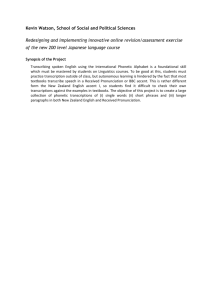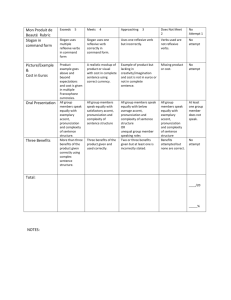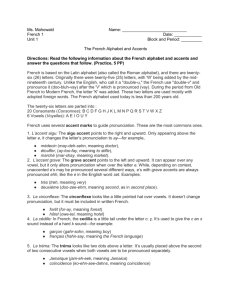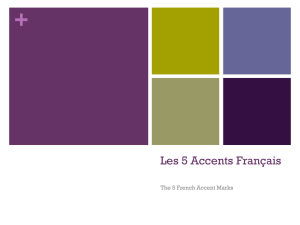Pronunciation Workshop Speaker Notes
advertisement
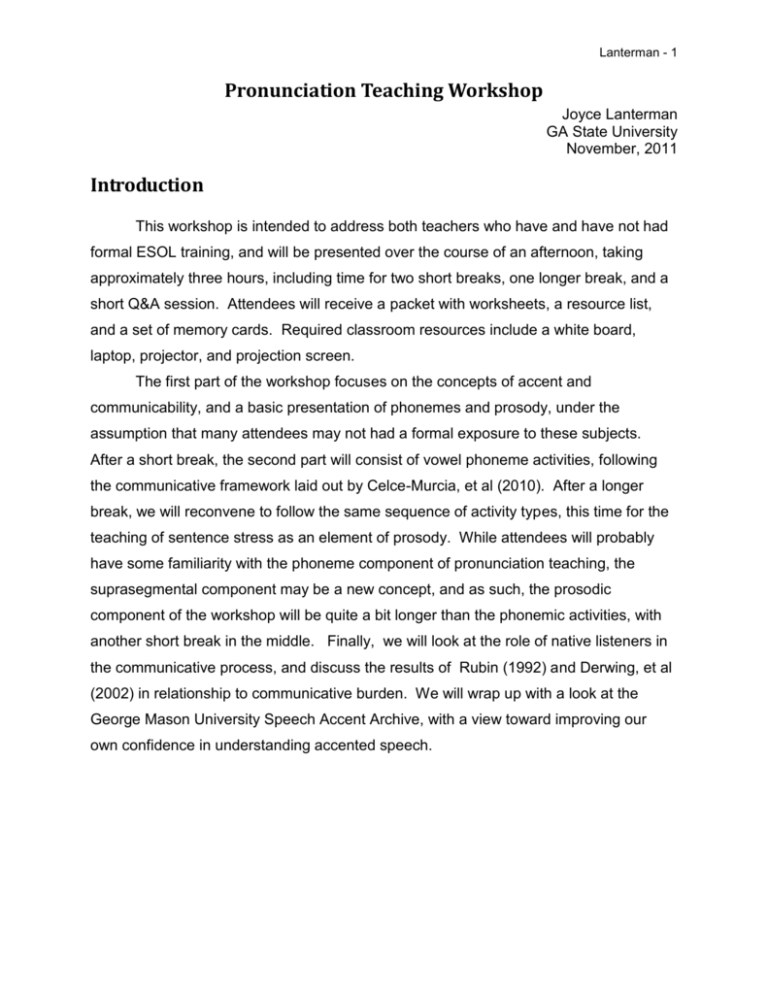
Lanterman - 1 Pronunciation Teaching Workshop Joyce Lanterman GA State University November, 2011 Introduction This workshop is intended to address both teachers who have and have not had formal ESOL training, and will be presented over the course of an afternoon, taking approximately three hours, including time for two short breaks, one longer break, and a short Q&A session. Attendees will receive a packet with worksheets, a resource list, and a set of memory cards. Required classroom resources include a white board, laptop, projector, and projection screen. The first part of the workshop focuses on the concepts of accent and communicability, and a basic presentation of phonemes and prosody, under the assumption that many attendees may not had a formal exposure to these subjects. After a short break, the second part will consist of vowel phoneme activities, following the communicative framework laid out by Celce-Murcia, et al (2010). After a longer break, we will reconvene to follow the same sequence of activity types, this time for the teaching of sentence stress as an element of prosody. While attendees will probably have some familiarity with the phoneme component of pronunciation teaching, the suprasegmental component may be a new concept, and as such, the prosodic component of the workshop will be quite a bit longer than the phonemic activities, with another short break in the middle. Finally, we will look at the role of native listeners in the communicative process, and discuss the results of Rubin (1992) and Derwing, et al (2002) in relationship to communicative burden. We will wrap up with a look at the George Mason University Speech Accent Archive, with a view toward improving our own confidence in understanding accented speech. Lanterman - 2 Pronunciation Workshop Speaker Notes Part 1: Accent and Communication Slide 1 – What is Accent? Accent is the first impression of language, "lens through which we are viewed (Celce-Murcia et al p279)" in our interactions -1st signal that someone is not speaking "standard" English. Do Bearded Dude and The Queen speak the same way? Why not? What are some differences in the way people from NY talk, vs people from Australia? Faster/slower Vowel differences Vocab differences Intonation differences Slide 2 – Whose English is It, Anyway? What's a native accent? Native of where? We're teaching in Georgia, but some of us are from other places. Whose accent do we teach? Answer: Speak in your accustomed accent. If your accent is different from other models, use this as a teaching point--there's more than one "right way" to say something. Trying to train students for a "native-like" accent is a losing battle. According to Selinker (1972), only about 5% of adults achieve native-like competence in a second language after puberty. You're setting them up for likely failure if you try. Approx 80% of English speakers are non-native. (Levis 1999) Slide 4 - Accent "Reduction" Model: Most people would say that these differences are errors, that they are problematic and should be corrected. But this is kind of arrogant – assumes no agency on part of learner. So where do we draw the line between differences and errors? Slide 6 - A Different Focus: Communication Rather than focus on what learners *can't* do (speak with a "native" accent), concentrate on what they need to be able to do: communicate Lanterman - 3 Slide 7 – Intelligibility NNS's goal is to ease communicative burden on listeners as much as possible. Rather than "no accent," focus should be: get the point across don't distract don't make listeners work too hard Slide 10 – Communicability Needs analysis: who are our students? What do they need English for? Part 2: Building Blocks of Speech Slide 12 – Phonemes Whether a sound is a phoneme depends on whether you make a new word, thus sounds can be phonemes in one word and not in another. So in /təmeido/ / təmato/ the contrasting vowels are not phonemes, because it’s still the same word. But /meid/ and /mad/ are two different words (maid, mod), thus the sounds are phonemes in this context. Slide 13 - Not All Phonemes are Created Equal Sounds not in native inventory? Turns out, not as important: /th/ in breath vs /th/ in breathe: there aren't that many contrasts, and the ones there are aren't used often. Slide 14 – Prosody Most programs concentrate on phonemes...but it turns out that prosody is equally important, if not more so. Examples: Stress: dessert/desert Rhythm: ICED double TALL NON-fat va-NILL-a LATT-e Intonation: “Yeah, right!” Agreement, or sarcasm? Connected Speech: What have you got? /wʌtʃə gat/ Lots of chocolate! /latsə tʃaklət/ Note: this is not “lazy” or “sloppy” speech, or even necessarily “informal.” It’s simply the consequence of talking. Part 3: Sample Lessons Slide 23 – Phonetic Vowel Chart IPA looks complicated, but can be very helpful when spelling doesn’t match pronunciation. Students will probably see it in dictionaries, so it’s helpful to familiarize them with it. Don’t have to teach it all at once! Just as issues come up. Lanterman - 4 Slide 24 – Vowel Lip Shapes Lip reading exercise - can you tell what vowel I'm making? Trick for pronouncing French /y/: shape lips like /u/ but shape inside of mouth like /i/ Slide 26 - In Defense of Choral Repetition "lost in the crowd" – don’t worry if you can’t hear individuals, this is not an assessment tool but a practice tool Noticing differences step = description/analysis, focused listening Steps 2-3 are the guided and communicative practice. Slides 27-28 - Vowel Phonemes: Controlled Practice Animals with /I/ Contrasting foods with /I/ and /i/ fish milk/cheese insect chicken/peaches inch worm For beginners, provide a word box and tell them to group the words acc to vowel sound Slide 29 – Vowel Phonemes: Guided Practice (Family Tree) Provide a word box for beginners; have more advanced students come up with names on their own. Slide 30-31 - Vowel Phonemes: Guided Practice (limericks) Also note alliteration of "nose" and "knees" Make it easier by providing part of speech or a word box. If you provide a word box, students can first group words according to vowel Slide 34 - Sample Lessons: Sentence Stress Note secondary stress on “green” – it’s a content word, but rhythm demands alternation of stressed elements. Slide 37: Sentence Stress: Description and Analysis Demonstrate using the rubber bands to show longer stressed syllables. Slide 41 - Sentence Stress: Guided Practice Note contrastive stress: What do YOU do? Highlights new information, contrast from previous question Slide 47: Listening to Accented English Select a speech sample to listen to. Demo search features, point out phonetic transcript and generalizations about speaker’s accent. Lanterman - 5 References Celce-Murcia, M., Brinton, D., Goodwin, J., & Griner, B. (2010). Teaching pronunciation: A course book and reference guide (2nd edition). Cambridge University Press: NY Cook, V. J. (1992). Evidence for multi-competence. Language Learning, 42, 4, 557591. Derwing, T. M. (2010). Utopian goals for pronunciation teaching. In J. M. Levis & K. LeVelle (Eds.), Proceedings of the 1st Pronunciation in Second Language Learning and Teaching Conference (pp. 24-37). Ames, IA: Iowa State University. Derwing, Tracey M., Marian J. Rossiter, & Murray J. Munro (2002). Teaching Native Speakers to Listen to Foreign-Accented Speech. Journal of Multilingual and Multicultural Development 23 (4), 245-259 Firth, S. (1992). "Pronunciation syllabus design: A question of focus," pp. In Avery, P. and Ehrlich, S (Eds), Teaching American English Pronunciation. 173-181. Oxford University Press. Gilbert, J. (1994). Intonation: A navigation guide for the listener. In Joan Morley (Ed.), Pronunciation pedagogy and theory. Alexandria, VA.: TESOL, 36-48. Grant, Linda. (2011, October). Integrating Pronunciation in ESL Education. Classroom lecture at GA State University, Atlanta, GA. Hahn, L. D. (2004). Primary stress and intelligibility: Research to motivate the teaching of suprasegmentals. TESOL Quarterly, 38(2), 201-223. Kjellin, O. (1999). Accent Addition: Prosody and Perception Facilitates Second Language Learning. In O. Fujimura, B. D. Joseph, & B. Palek (Eds.), Proceedings of LP'98 (Linguistics and Phonetics Conference) at Ohio State University, Columbus, Ohio, September 1998 (Vol. 2, pp. 373-398). Prague: The Karolinum Press. Levis, J., & Grant, L. (2003). Integrating pronunciation into ESL/EFL classrooms. TESOL Journal, 12(2), 13-19. Lanterman - 6 Lindemann, Stephanie (2002). Listening with an attitude: A model of native-speaker comprehension of non-native speakers in the US. Language in Society 31(3), 419-441. Lippi-Green, Rosina (1997). English with an Accent: Language, Ideology, and Discrimination in the United States. New York: Routledge. Chapter 9, 176-201 & Chapter 11, 217-239. Morley, J. (1994). Multidimensional curriculum design for speech-pronunciation instruction. In J. Morley (Ed.), Pronunciation Pedagogy and Theory: New Views, New Directions. (pp. 64-91). Alexandria, Va: TESOL. Murphy, J. (manuscript in preparation). Models for Pronunciation Instruction: HighAchieving, Accented, Intelligible, Comprehensible ESL Speakers. AL/ESL Department, GSU. Schneiderman, E. I., & Desmarais, C. (1988b). The Talented Language Learner: Some Preliminary Findings. Second Language Research, 4 (2), 91-109.

